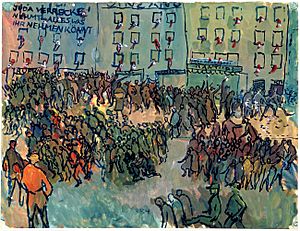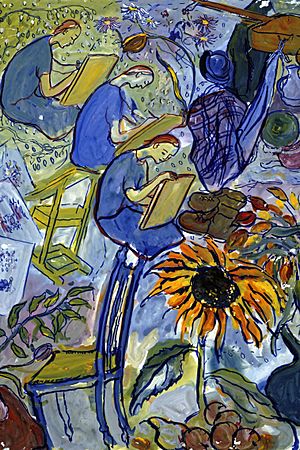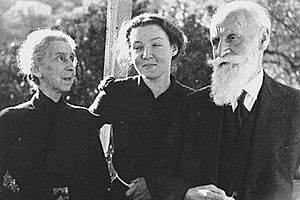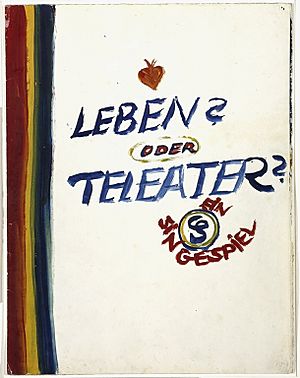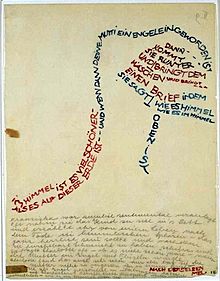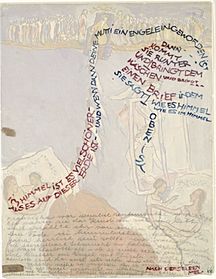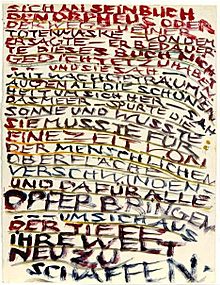Charlotte Salomon facts for kids
Quick facts for kids
Charlotte Salomon
|
|
|---|---|
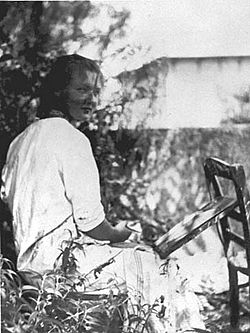
Charlotte Salomon painting in the garden of the Villa L'Ermitage, Villefranche-sur-Mer, about 1939
|
|
| Born | 16 April 1917 |
| Died | 10 October 1943 (aged 26) Auschwitz-Birkenau, German-occupied Poland
|
| Nationality | German |
|
Notable work
|
Leben? oder Theater?: Ein Singspiel |
| Movement | Expressionism |
| Spouse(s) | Alexander Nagler |
Charlotte Salomon (born April 16, 1917 – died October 10, 1943) was a talented German-Jewish artist from Berlin. She is best known for her amazing series of paintings called Leben? oder Theater?: Ein Singspiel (Life? or Theater?: A Song-play). This huge collection has 769 individual artworks. Charlotte painted them between 1941 and 1943 in the south of France. She was hiding from the Nazis at that time. In October 1943, Charlotte was captured. She was sent to Auschwitz, where she sadly died soon after arriving.
Contents
Who Was Charlotte Salomon?
Charlotte Salomon grew up in a well-off family in Berlin. Her father, Albert Salomon, was a surgeon. Her mother, Franziska, passed away when Charlotte was only eight or nine years old.
When the Nazis came to power in 1933, Charlotte was sixteen. Life became very difficult for Jewish people in Germany.
Studying Art in Difficult Times
In 1936, Charlotte was able to get into a special art school in Berlin. This was hard because German universities limited how many Jewish students they would accept. She studied painting there for two years.
By the summer of 1938, it was too dangerous for her to continue. The Hitler's Third Reich had very strong anti-Jewish rules. Even though she won an award, she could not go back to college.
Leaving Germany for Safety
In November 1938, after an event called Kristallnacht, Charlotte's father was briefly held in a concentration camp. Because of this, the Salomon family decided to leave Germany.
Charlotte was sent to the South of France. She went to live with her grandparents, who were already in Villefranche-sur-Mer near Nice. They stayed in a small house on the property of a rich American woman, Ottilie Moore. Ms. Moore later helped many Jewish children hide from danger.
Challenges and a New Path
Charlotte and her grandparents moved to an apartment in Nice. Soon after World War II started in September 1939, Charlotte's grandmother died.
Charlotte and her grandfather were then held by French officials in a tough camp in the Pyrenees mountains called Gurs. They were released because her grandfather was unwell. He went back to Nice. Charlotte had a very difficult time in Villefranche. A local doctor, Dr. George Morridis, suggested she try painting.
Life? or Theater? (Leben? oder Theater?)
Charlotte rented a room and began her incredible artwork. She started her series of 769 paintings, calling it Life? or Theater?. She said she was driven by the choice to create something "wildly unusual."
In just two years, she painted over a thousand gouaches (a type of watercolor paint). She then organized them, added texts, captions, and transparent overlays. She often hummed songs while she painted.
This entire work was like a slightly fantastical autobiography. It showed the main events of her life. These included her mother's death, studying art during the Nazi era, and her relationship with her grandparents. She changed names and added a lot of imagination. She also included notes about music that would fit the scenes. She called Life? or Theater? a "Singespiel" [sic], which means a lyrical drama.
A big part of Life? or Theater? is about her strong connection with Amadeus Daberlohn. He was a voice teacher she met through her stepmother. Charlotte gave all her characters funny, often punny, made-up names. These parts of her work honestly show her passionate relationship with Alfred Wolfsohn. He was the only person who took her art seriously.
What is a Singspiel?
Charlotte called her work Leben? oder Theater?: Ein Singespiel. A Singspiel is a German musical play. It's a bit like an operetta. In a Singspiel, actors often speak their lines instead of singing them. Music plays in the background.
Singspiel plays are usually funny, but sometimes they can be sad. Love stories are often a big part of them. Famous composers like Mozart and Schubert wrote Singspiel works. Charlotte's spelling, "Singespiel," has an extra "e," but we don't know if that was on purpose.
So, Life? or Theater? is more than just paintings. It has a script with words painted into the images or on overlays. It also has a "soundtrack" – music Charlotte chose to go with her stories. This music ranges from Nazi marching songs to classical pieces by Schubert, Mozart, and Mahler. Her work is huge, very modern, and truly one-of-a-kind.
Special Overlays and Meaning
Her work includes about two hundred transparent sheets with text. These are meant to be placed over the gouache paintings. The pictures above show how this works. One example shows the fictional Charlotte Kann (who represents Charlotte Salomon herself) in bed with her mother. Her mother tells her how wonderful Heaven is. She says she will go there one day and leave a letter for Charlotte about life in Heaven.
The "signature image" of Life? or Theater? is the very last picture. It shows Charlotte Salomon kneeling by the sea. She has a brush and paper in her hand. The words Life or Theater are written on her back.
The final words of her work, inspired by Alfred Wolfsohn, are:
-
...und sie sah – mit wachgeträumten Augen all die Schönheit um sich her – sah das Meer spürte die Sonne und wusste: sie musste für eine Zeit von der menschlichen Oberfläche verschwinden und dafür alle Opfer bringen – um sich aus der Tiefe ihre Welt neu zu schaffen
Und dabei entstand
das Leben oder das Theater???... And with dream awakened eyes she saw all the beauty around her, saw the sea, felt the sun, and knew she had to vanish for a while from the human surface and make every sacrifice in order to create her world anew out of the depths.
And from that came
Life or Theater???
Charlotte's Final Days
In 1942, Charlotte joined her grandfather in Nice. Her permit to live there depended on her taking care of him.
In 1943, the Nazis were searching more intensely for Jewish people in the South of France. Charlotte gave her collection of paintings to a local doctor she knew. She told him, "Keep this safe, it is my whole life." She addressed it to Ottilie Moore, the wealthy American who owned the villa where Charlotte had hidden. Ms. Moore received the package after the war ended in 1947.
By September 1943, Charlotte had married another German Jewish refugee, Alexander Nagler. They were taken from their home and sent by train to a Nazi camp near Paris called Drancy. Charlotte was five months pregnant at this time. She was sent to Auschwitz on October 7, 1943. She died in the gas chamber on the same day she arrived, October 10.
Charlotte Salomon's Legacy
The paintings from Life? or Theater? were first shown in the 1960s. The first book of her art was published in 1963. People compared her story to that of Anne Frank. The famous artist Marc Chagall saw the paintings and was very impressed.
In 1971, her collection was given to the Joods Historisch Museum in Amsterdam. In 1981, the museum showed 250 scenes in order, and art critics started talking about her work. An exhibition in London in 1998 was a big surprise success. Charlotte's work is still not widely known. This is partly because her art is not sold in the art market. The entire collection belongs to the Charlotte Salomon Foundation at the Joods Historisch Museum.
An animated movie called Charlotte, based on her life and paintings, came out in 2021. It features the voice of Keira Knightley as Charlotte in the English version.
Remembering Charlotte Salomon
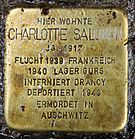
Since 1992, a primary school in Berlin has been named after Charlotte Salomon. In 2006, a street in Berlin-Rummelsburg was also named after her. On April 21, 2012, a Stolperstein (a small memorial stone) was placed in front of her former home in Berlin-Charlottenburg. A special plaque on the building also remembers the artist.
Images for kids
See also
 In Spanish: Charlotte Salomon para niños
In Spanish: Charlotte Salomon para niños


